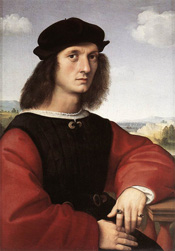| |  | Raphael |  |
| "Time is a vindictive bandit to steal the beauty of our former selves." *** Italian in full RAFFAELLO SANZIO (1483-1520), master painter and architect of the Italian High Renaissance. Raphael is best known for his Madonnas and for his large figure compositions in the Vatican in Rome. His work is admired for its clarity of form and ease of composition and for its visual achievement of the Neo-Platonic ideal of human grandeur. After the complexities of Leonardo and Michelangelo, it is a relief to find Raphael, a genius no less than they, but one whose daily ways were those of other men. |  |
Raphael was born in the small town of Urbino, an artistic centre, and received his earliest training from his father. Later, his father sent him to Pietro Perugino (active 1478-1523) who, like Verrocchio and Ghirlandaio, was an artist of considerable gifts. But while Leonardo and Michelangelo quickly outgrew their teachers and show no later trace of influence, Raphael had a precocious talent right from the beginning and was an innate absorber of influences. Whatever he saw, he took possession of, always growing by what was taught to him. Raphael spent his first sojourn in Florence (1504-08) to sublime purpose. At that time Leonardo and Michelangelo were both working there, and as a result Raphael adopted new working methods and techniques and his paintings took on a more vigorous graphic energy. Raphael's life was short, but while he lived he was one of those geniuses who continually evolve and develop. He had an extraordinary capacity to respond to every movement in the art world, and to subsume it within his own work. Raphael is out of favor today; his work seems too perfect, too faultless for our slipshod age. Yet Raphael's great icons of human beauty can never fail to stir us: his Vatican murals can stand fearlessly beside the Sistine ceiling. "The School of Athens", for example, monumentally immortalizing the great philosophers, is unrivalled in its classic grace. Raphael's huge influence on successive artists is all the more impressive considering his short life. |
|
| |
|  | | "The Small Cowper Madonna" (circa 1505) Oil on wood, 59.5 x 44 cm - 23 3/8 x 17 3/8 in. National Gallery of Art, Washington, D.C., USA. | | |  | 
|  | | "St. George Fighting the Dragon" (1504-06) Oil on wood, 28.5 x 21.5 cm - 11 1/8 x 8 3/8 in. National Gallery of Art, Washington, D.C., USA. | | | | 
|  | | "Bindo Altoviti" (circa 1515) Oil on wood, 60 x 44 cm - 23 1/2 x 17 1/4 in. National Gallery of Art, Washington, D.C., USA. | | | | 
|  | | "The Alba Madonna" (circa 1511) Oil on canvas. National Gallery of Art, Washington, D.C., USA. | | | | 
|  | | "Wedding of the Virgin" (1504) Oil on panel, 170 × 117 cm - 66.9 × 46.1 in. Brera, Milan, Italy. | | | | 
|  | | "The School of Athens" (1509) Fresco. Stanza della Segnatura, Palazzi Pontifici, Vatican City State, Rome, Italy. | | | | 
|  | | "Stanza della Segnatura" (1510-1511) Fresco, width: 670 cm - 263.8 in. Stanza della Segnatura, Palazzi Pontifici, Vatican City State, Rome, Italy. | | | | 
|  | | "Portrait of Agnolo Doni" (1506) Oil on wood, 45 x 63 cm - 17.72 x 24.8 in. Galleria Palatina, Palazzo Pitti, Florence, Italy. | | | | 
|  | | "Portrait of Maddalena Doni" (1506) Oil on wood, 45 x 63 cm - 17.72 x 24.8 in. Galleria Palatina, Palazzo Pitti, Florence, Italy. | | | | 
|  | | "Madonna of Belvedere" (1506) Oil on wood, 88 x 113 cm - 34.65 x 44.5 in. Kunsthistorisches Museum, Vienna, Austria. | | | | 
|  | | "Portrait of a Cardinal" (1510-11) Oil on wood, 61 x 79 cm - 24.02 x 31.1 in. Museo del Prado, Madrid, Spain. | | | | 
|  | | "The Triumph of Galatea" (1511) Fresco, 225 x 295 cm - 7' 4.58" x 9' 8.14". Villa Farnesina, Rome, Italy. |
| Text source: 'Webmuseum' (www.ibiblio.org/wm). | |
|
|